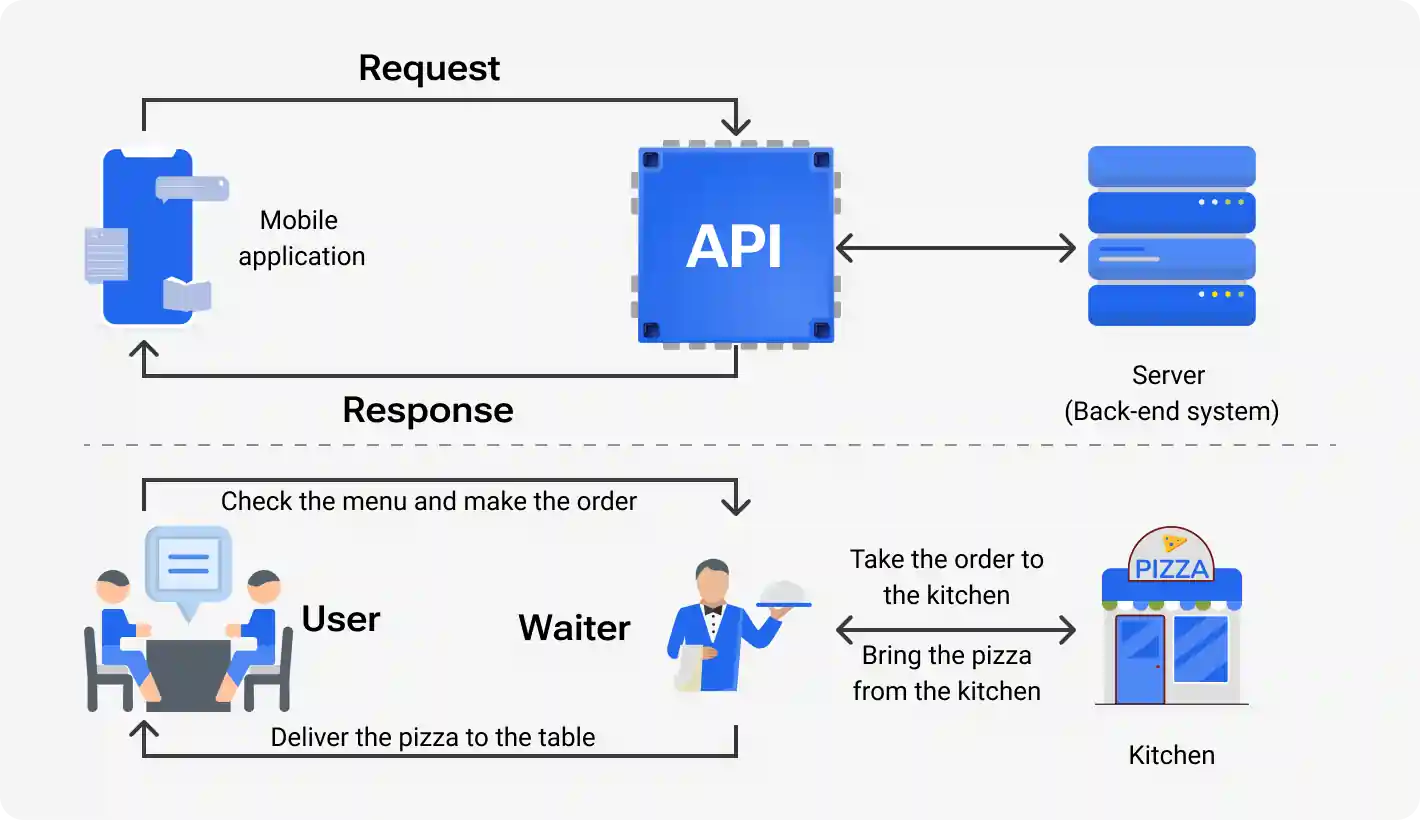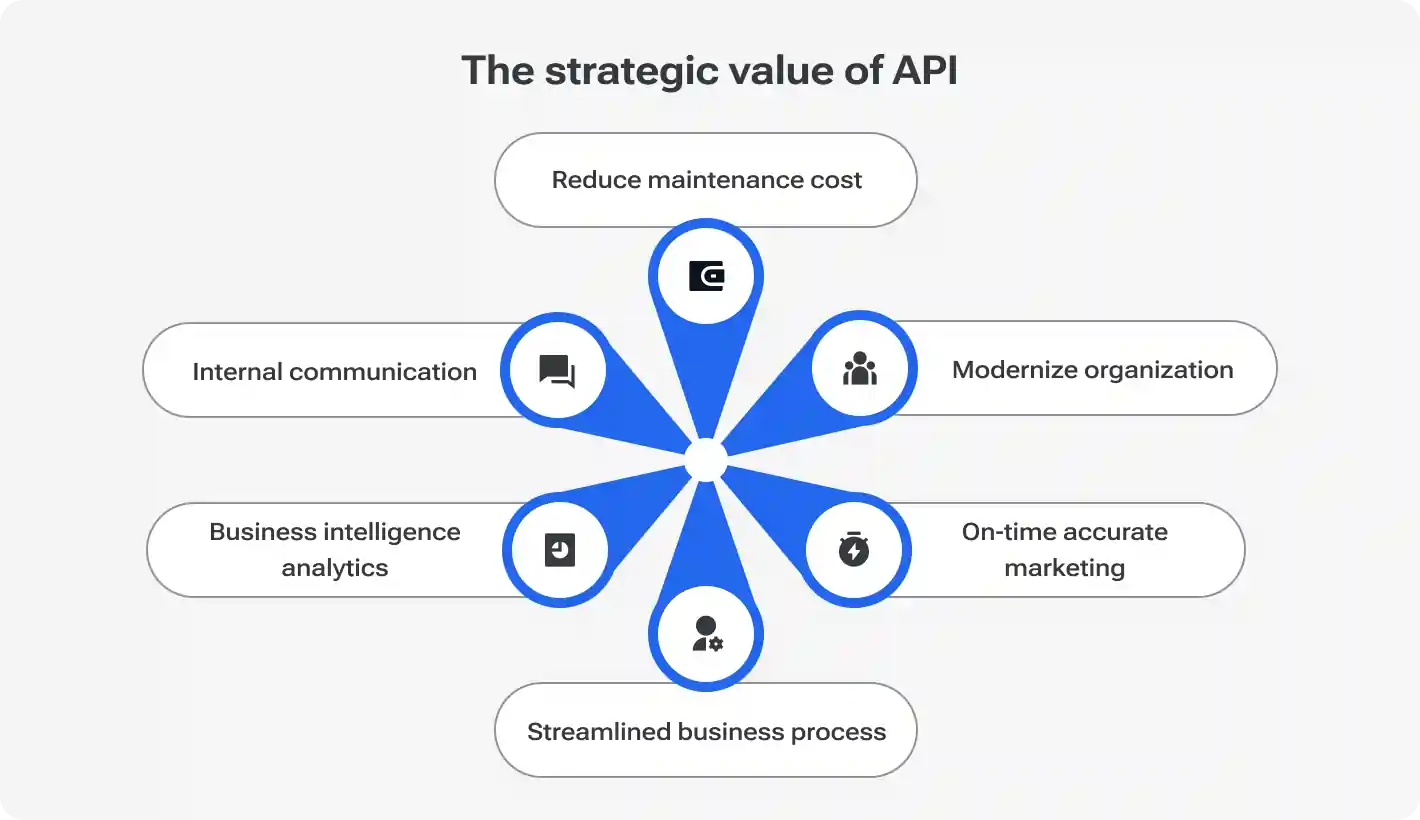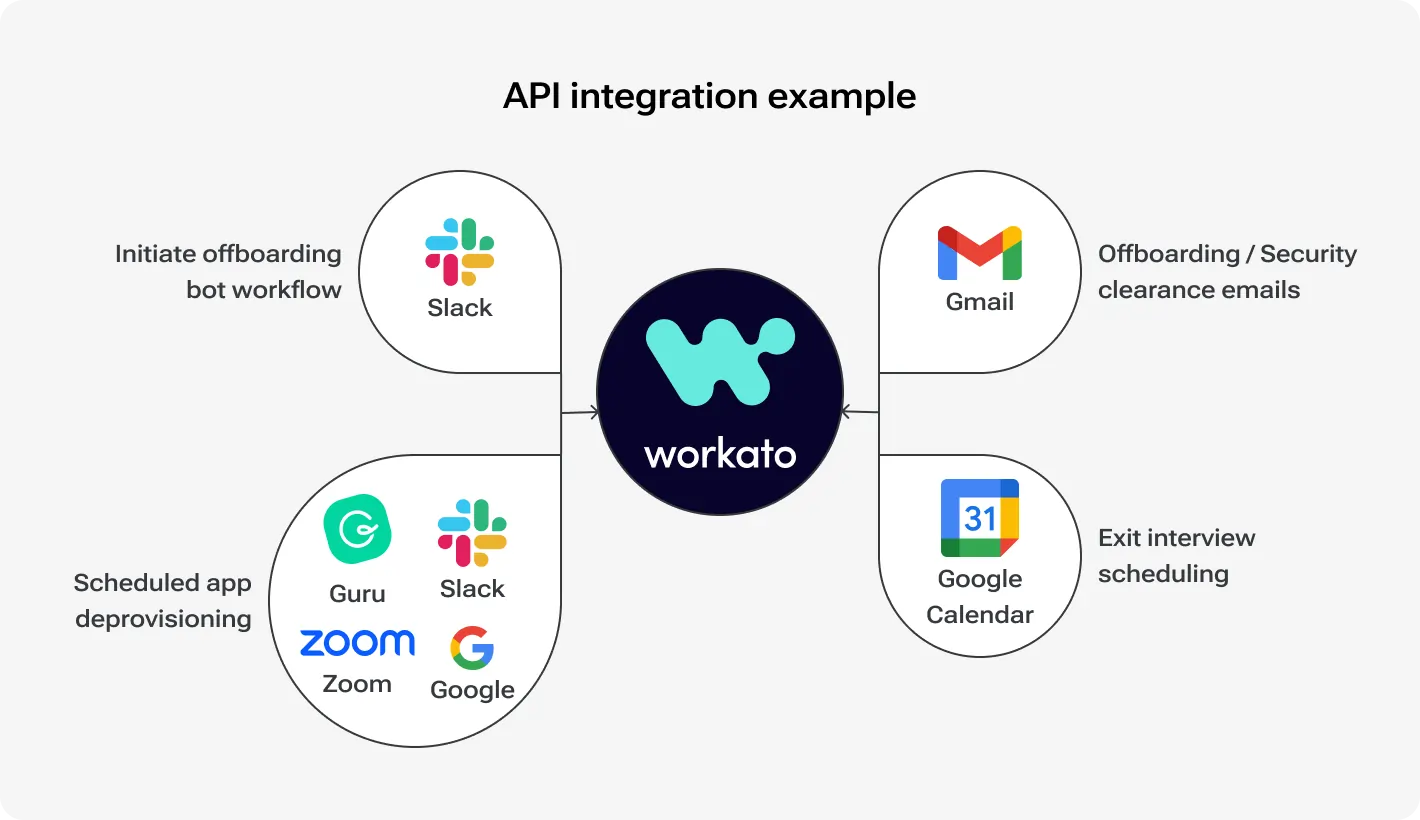APIs have become a cornerstone of success for modern web-based businesses, playing a crucial role in the functionality and scalability of websites and applications. According to Deloitte research, 77% of companies with successful API management transformations translate their strategy into operational mechanisms, monitoring progress, and making changes.
This article aims to simplify the complexities of APIs, making them easy to understand for everyone—whether you're an entrepreneur, developer, marketer, or just someone interested in exploring the wide range of possibilities that APIs provide.
We'll start with API basics, including requests and responses, endpoints, methods, and data formats. From there, we'll delve into how APIs function in practical terms, explore their numerous benefits, and share some of the most popular real-world examples to illustrate their impact.
Bridge the gap with seamless API solutions for product integration
What is an API?
Application Programming Interface allows two software components to communicate and exchange data via a shared set of protocols. In simple terms, when two apps or databases “talk” to each other to retrieve information and present it to users, they are most likely doing it via an API.
API is not just a building block: it is like a rope connecting a platform or an application to the end source it requests information from. Henceforth, there are lawyers to the API structure. Since it is an interface, it joins two software systems together, incentivizing them to communicate and facilitating this process. The communication itself happens through the concept of requests and responses.
This concept is as simple as, for instance, using a restaurant menu or a waiter to communicate your order to the kitchen, where cooks receive your request and provide a response in the form of a ready dish of your choice. In the same way, you can retrieve information from websites and applications online using one API and send your requests through it.
How APIs work
In order to better understand the concept of APIs and how APIs work and process user commands, you have to grasp the essence of requests and responses, endpoints, methods, and data formats. Below is the breakdown of all these phenomena and examples in all detail.
Request and response: understanding the API request-response cycle
The cycle of work for any API consists of requests and responses.
Request: When a client (it can be a website or a mobile application) needs information or a service from an API (Application Programming Interface), it forms and sends a request. Once again, think of it like ordering food at a restaurant: you tell the server what you want by specifying items from the menu. Similarly, in an API request, the client specifies what data or action it wants from the API, and the API proceeds to retrieve the requested data;
Response: Once the API receives the request, it processes it, obtains the required information, and sends back a response. This response is like the waiter bringing you your meal after the cooks have it. The response contains the requested information or a confirmation that the action (like saving a file or deleting it) was completed.
Endpoints and methods
Two other important concepts to differentiate between are endpoints and methods.
Endpoints: These are specific URLs where an API can be accessed. Each endpoint represents a different part of the service you are accessing. For example, if you’re interacting with an API for a weather service, one endpoint might be used to get the current weather for a requested city, while another endpoint might provide a 7-day forecast for the same location.
Methods: Methods describe what kind of action you want to perform at a specific endpoint. Common methods for APIs are called GET and POST. GET is used to retrieve the data, for example, the information about the weather in a specific city. At the same time, POST is used to send, submit, delete, or change data, for instance for submitting a form or uploading a file.
Data formats
When the API sends data back to you, it usually does so in a specific format. The two most common formats are:
JSON (JavaScript Object Notation): This format is lightweight and easy for humans to read. It looks like a simple list of key-value pairs, like a dictionary or an address book.
XML (eXtensible Markup Language): This format is a bit more structured and looks like HTML.
In summary, JSON is often simpler and quicker for modern applications, while XML is more detailed and structured. Both serve the same purpose: to package the data being shared between the client and API.
Benefits of using APIs
If you’re planning to use an API for any purpose in your mission, you must consider the key API benefits described below.
How APIs allow different systems to connect and work together seamlessly
APIs are like translators between different systems or software components. Most often, these systems have different languages and ways of processing data, but API uses a common set of rules shared between the two so that they can communicate and exchange information with each other seamlessly. As a result, it’s basically the same as two strangers communicating with each other using a translator because they don’t share a common language.
If you have ever booked a flight on an aggregator website like, for example, Skyscanner, you have probably noticed that it gathers flight data from different airline websites and travel agencies. In addition, it shows hotel availability from booking systems like Booking, and even car rental services in the location of your choice. All these services are showcased on the same platform without complications exactly because the aggregator uses an API to contact other services for information.
How APIs streamline processes and speed up development
Developers can reuse APIs many times and for different purposes thanks to their pre-build functionality. Instead of building every aspect or feature of an API from scratch, developers can access the set of existing tools, services, or data.
For instance, if the task is to create a complex payment processing system, a developer can benefit from an API of a service like PayPal or Stripe. In this way, developers will focus on their core products while relying on APIs for other tasks.
How APIs enable the creation of new features and services by building on existing ones
Thanks to APIs, developers can build new applications or features on top of existing ones, which practically means “plugging in” to other platforms.
A common example of such a connection is to allow users of a social media app to use Google Maps API for tagging their locations or integrating weather services to display local forecasts for their cities. Instead of starting from scratch for a similar mission, developers can access external services through their APIs and add new features quickly and more efficiently.
How APIs support the growth and scalability of applications
The more a certain business grows, the more data it needs to process. As a result, its services are under constant pressure because they must gradually process more users, services, and information. The best way to facilitate and speed up this process is by using an API.
APIs allow apps and websites to work with multiple systems and distribute tasks equally between them. As a result, such programs as food delivery services can communicate with multiple restaurants, payment providers, and delivery services at once. In this way, a service will grow and expand without the need to rebuild its infrastructure from scratch.
Popular examples of successful API integrations
API is a universal tool for all business sectors. It serves multiple purposes depending on the purpose that you are trying to achieve. We'll show you some API examples with the most common integrations, the main features, and the purposes of API use.
API for graphic interface creation
Vulkan is a cross-platform API through which developers can use for graphic interfaces and computing. It is a golden standard of a graphic API that gives its user full access to the GPU in order to control its functions and maximize performance. By using Vulkan, video games can get the most out of the performance of every player’s hardware.
Weather API
Weather APIs provide geolocation and meteorological information to websites and applications that require it. The scope of services can range from simple weather forecasting to time zones and even astronomical information. As an example, you can check OpenWeather API, where you can get current weather and forecasts, weather data for any timestamp and daily aggregation.
APIs for Microservices
Microservices architecture is a type of API design that divides it into a collection of small independent components. One of the popular platforms using a microservices architecture for its API is Netflix. Thanks to the architecture, the platform can perform user account management, recommendation algorithms for movies and TV shows, content delivery and regular updates, and many more.
APIs for SaaS
APIs for SaaS are popular across marketing automation platforms: Eloqua, HubSpot and Marketo. Through seamless API integration, customers can get quick access to their offerings and even opt in for regular subscription packages. Companies benefit from using SaaS-tailored APIs because they help with achieving a targeted clientele faster.
Why your business needs API integration now more than ever
APIs for cloud services
APIs for cloud services allow developers to manage, provision, and access cloud resources programmatically. They enable task automation and seamless integration of cloud services into applications, helping businesses adapt to evolving conditions and traffic demands. According to the Harvard Business Review, 50% of the leading cloud-based software company revenue is by API.
APIs for web metrics
APIs are also frequently used to provide programmatic access to web metrics. For instance, a company wanting to track traffic on their website can embed JavaScript code from web analytics services into their page templates. When a visitor accesses the site, the code triggers an API call, sending data such as traffic stats, user location, browser type, and more. Many analytics providers also offer tools for compiling this data into reports, helping businesses gain valuable insights.
APIs for banking
Banking APIs allow app developers to integrate banking services into their applications. For instance, accounting software companies can utilize these APIs to automate tasks such as account reconciliation, electronic payment processing, and tax filings. Additionally, banking APIs provide users with real-time and current financial data. According to McKinsey Digital, banks plan to triple the number of their “public APIs” by 2025.
APIs for payment processing
Payment processing APIs from providers such as PayPal, Stripe have significantly accelerated digital commerce and donations. By facilitating secure credit card transactions on web and mobile platforms, these APIs offer businesses a dependable method for handling payments without the need to develop and manage intricate payment systems themselves.
APIs for shipment tracking
USPS and FedEx offer APIs for shipment tracking that companies can integrate into their web and customer service platforms. This integration helps ensure timely deliveries and offers customers greater transparency.
In essence, shipment tracking APIs enable businesses to enhance internal operations and boost customer satisfaction. For instance, they can optimize supply chain and logistics management and prevent failed deliveries by proactively scheduling drop-offs and pick-ups.
APIs for supply chain management
Similarly, companies can leverage supply chain management APIs to stay informed about order statuses and inventory availability. These tools are particularly valuable for retailers, e-retailers (eg. Shopify), manufacturers, distributors, shipping and transportation firms, as well as inventory and warehouse management companies.
APIs for mapping and location services
Services such as Google Maps and Apple Maps utilize APIs to provide customers with location-based features like routing, trip guidance, and coordinated marketing services. For instance, Airbnb and Uber use the Google Maps API for mapping and vehicle tracking, while DoorDash and Instagram leverage the Apple MapKit API for order tracking and geotagging.
APIs GDPR compliance
According to IBM, API gateways play a crucial role in meeting GDPR requirements for transmitting large volumes of data. By implementing effective API management, administrators can better control access to integrations, simplifying the process of achieving GDPR compliance.
The path to smooth API integration: Expert tips and tricks
Common misconceptions about APIs
Along with the popularity of APIs, the number of API misconceptions grows. The table below is designed to debunk some of the common myths about APIs, their functions, and integration.
Myths about APIs
Clarification
APIs are only for developers
APIs come in various types for different purposes, some of which are quite simple. If you lack experience in developing or integrating APIs for your business, you can collaborate with a partner company.
APIs are too complex to understand if you are not a pro
APIs have different structures and underlying technology depending on their purpose. So, it is possible to learn the approach of building a particular API, especially if you have an expert to teach you the basics.
APIs are almighty and can do literally everything
An API is a tool for accessing a specific set of functions or data. It is usually part of a broader system or service and must be combined with other components or APIs to create a complete solution.
APIs only exist for external integrations
APIs are just as essential for internal communication within organizations, allowing different components of a system, such as microservices, to interact seamlessly. Internal APIs support data sharing, workflow automation, and system communication.
APIs only serve big tech companies
APIs are equally valuable for small businesses and startups, enabling them to access advanced features like payment processing, data analytics, or cloud services without developing these in-house.
APIs always work seamlessly and without bugs
APIs can encounter issues such as misconfigurations, version incompatibilities, or security vulnerabilities. Proper testing, monitoring, and error handling are essential to ensure smooth API performance.
APIs offer free trials, especially for limited use. However most have usage limits or require payment for premium features, higher call volumes, or extended functionalities. Pricing models vary across providers.
APIs are less secure than they are claimed to be
Security risks typically arise from poor implementation or misconfigurations, not the API itself. Since APIs are designed with robust security features like encryption, authentication (OAuth, API keys), and rate limiting, when properly managed, APIs offer strong security.
How to start with APIs
Now that we have fueled your interest in APIs, improved your general understanding, and debunked some of the most widespread myths, you can get down to business with the creation of your own API. Where to start? Here are some useful tips.
Choosing the right API development partner: What to look for
1. Understanding needs
For starters, identify what exactly you need to achieve with an API. There can be multiple different use-cases for a single API:
Integrating some external data into your website or application by accessing the information from another source;
Automating tasks like data collection, payments, subscriptions, and many more;
Creating a watertight connection with a specific service in order to list its offerings on your website or in an app;
Improve the performance of your product, such as using the Vulkan API to achieve the best graphics for a video game;
Expanding your clientele by offering quick subscription plans via an API.
Besides, don’t forget to define the specific functions you require from an API. For instance, weather forecasting or location services, payment processing, social media integration, or whatnot. Then, of course, stick to the key definitions and concepts we have provided in this article, such as endpoints, requests, responses, authentication, scaling, rate limiting, and so on.
2. Finding APIs
Explore the available APIs of the platforms or services you want to integrate with. A lot of platforms have their APIs in open access, henceforth you can study their functions and features before integrating. Besides, you can use API directories like ProgrammableWeb or RapidAPI to find APIs by category or visit the most popular marketplaces.
3. Testing APIs
For starters, resort to tools like Postman or Insomnia to test API requests and responses without writing code. In cases when the API requires authentication, obtain an API key or token from the provider and configure it in your testing tool.
To begin with testing, make a couple of simple GET requests to understand exactly the API response. Don’t forget to review the response formats and status codes. Then, explore and test different endpoints and HTTP methods to evaluate the performance of an API and see how it handles different operations.
Finally, once you are done with testing and fully comfortable with the API and its performance, you can start integrating it into your website or application. Run another test after the integration to make sure that everything is going smoothly and debug any possible issues if they occur.
Conclusion
APIs are key tools in software development, enabling seamless communication between different systems. While they rely on fundamental elements such as requests, responses, endpoints, methods, and data formats, their true value extends far beyond these basics. Strategic use of APIs can unlock innovative solutions and streamline business processes, turning ambitious ideas into reality.
Reflect on how APIs can be leveraged to propel your projects and optimize your business operations. The potential for transformative impact is significant, and with the right expertise, even the most complex challenges can be addressed. For personalized guidance and expert advice and tailored strategies contact Devico.
Struggling to connect your siloed systems? Hire a reliable API provider






